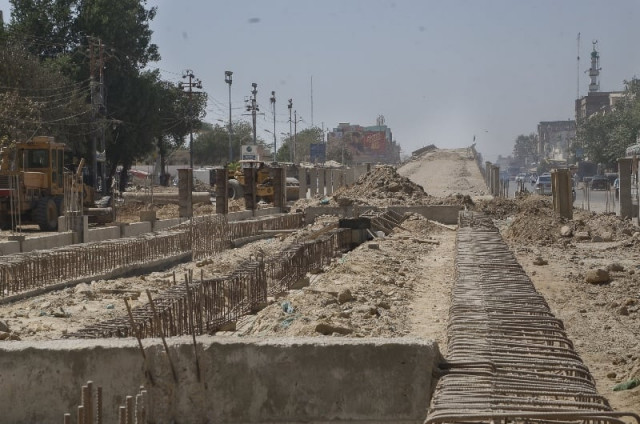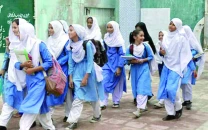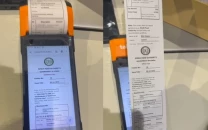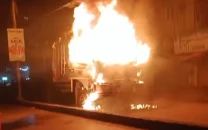Proposed Red Line BRT to connect Model Colony with Numaish
According to conceptual plan, ADB will finance the project for an estimated Rs30b

PHOTO: FILE
A unique feature of the proposed project, the Red Line BRT, is a cycling track that will be constructed along a portion of the project. The project, however, will require the recently renovated University Road to be dug up once again, wasting the over Rs1 billion utilised for its widening and reconstruction. The thoroughfare was inaugurated in June last year.
If the project sees the light of day, third generation BRT technology will be introduced in Karachi and 10 bus routes will be integrated through the special Red Line corridor. The project will restructure the bus transportation system as transporters will be asked to scrap their older buses and operate new buses along the integrated BRT line.
According to the plan, the government will give a subsidy to transporters for the purchase of new buses. The project's cost has been estimated at Rs30 billion and will be funded by the Asian Development Bank (ADB). Work on the project is expected to begin in December, 2018 and is expected to be completed by April, 2020.
‘Fragmented governance, weak institutional capacity affecting Karachi’s development’
Transport Minister Syed Nasir Hussain Shah told Daily Express that the government had initially planned to start off the project in May. However, the planning phase was time consuming and now the project will start in December, he said.
The transport minister claimed that the Pakistan Peoples Party-led Sindh government was very serious about resolving the transport issues of Karachi. He explained that many BRT projects were in the planning or construction phases in the city. Construction of the Orange and Green Line BRTs is under way, he said, adding that Blue and Yellow Line BRTs are still in the planning stages.
Shah was of the view that the proposed Red Line would not majorly affect the newly constructed University Road as the route for buses will be constructed on the median, leaving the rest of the road untouched. He explained that the project will be entirely funded by the ADB.
A transport department official told the Daily Express that after forming the conceptual plan of the Red Line BRT, the government is carrying out a survey so that a detailed design could be developed by July. The design will be sent to the planning commission for approval, the official said, adding that since the ADB will provide funds for the project, a sovereign guarantee will be required from the federal government.
NHA’s request for 400m of land along M-9 turned down
Salient features
According to the conceptual plan, the length of the BRT will be 21.5 kilometres and there will be 22 stations in total. The route will start from Model Colony and end at Numaish all the way through Malir Halt, Malir Cantonment Gate No 6, Safoora Chowrangi and University Road.
The corridor will be primarily constructed on ground level. There will be elevations at five places and an underpass near Mosamiyat Chowrangi so that the BRT does not obstruct the flow of regular traffic. Elevated U-turns will be constructed near Malir Cantt, Safoora Chowrangi and Karachi University.
According to the officer, first generation BRT technology is being employed in the Green Line and Orange Line BRTs, whereas in the proposed Red Line BRT, third generation BRT technology will be used. The third generation BRT concept allows other vehicles to run on the track besides the dedicated buses for the route. Therefore, public buses plying on as many as 10 routes will also be utilising the BRT track.
However, other buses on the track need to be new. For this, the Sindh government has proposed the Bus Industry Restructuring Programme, according to which owners of public buses operating on the 10 routes overlapping with the Red Line BRT will be encouraged to scrap their old buses and purchase new ones through public-private partnership mode. Subsidies will also be offered to transporters under the scheme to buy new buses.
PPP gifts ten buses to Karachi
At present, the number of routes overlapping with the Red Line BRT is 20 and around 200 minibuses and buses ply on them.
The conceptual plan also envisages an eco-friendly track where only cycles will run.
Re-digging University Road
According to the officers concerned, six metres is the required width of the track which will be taken from the median of the roads along the route. They explained that reconstruction of University Road is also a part of the project. It will be ensured that there are three lanes on both sides of University Road, the officials said, adding that footpaths on the road sides might be narrowed in order to maintain sufficient width of University Road.
Commenting on the potential digging-up and overhaul of University Road, which was completed in June last year by the local government department, Project Director Niaz Soomro said renovation of University Road was done before the Red Line BRT had been formally planned. He asserted that the government could not delay reconstruction of University Road at that time as it was in a dilapidated state due to which students of multiples universities and colleges situated on the road were facing trouble while commuting.
No progress made in development package for Karachi announced by Centre
Soomro added that while renovating University Road, provisions had been made for a future BRT project on the road. The road was widened so that its median could be used for transport projects, he said.
The reconstruction of University Road at a cost of over Rs1 billion was completed by the provincial local government department.
A transport department official revealed that the conceptual plan of the Red Line BRT was in accordance with the latest transport systems. However, he added that interest of the next federal and Sindh governments in the project would decide its fate.
The ADB will sponsor the project through a loan for which a sovereign guarantee will be required that will be provided by the federal government. This project will be completed only if the new Sindh and federal governments are serious about it.



















COMMENTS
Comments are moderated and generally will be posted if they are on-topic and not abusive.
For more information, please see our Comments FAQ